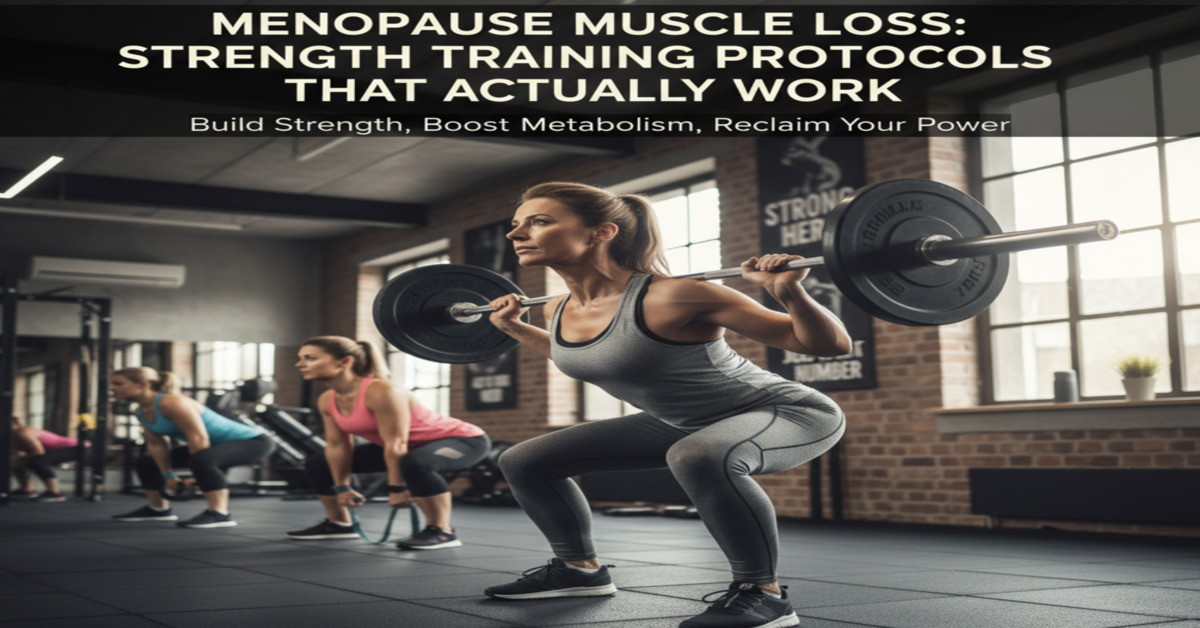Introduction
Menopause marks a powerful biological transition, but it also triggers a frustrating challenge for millions of women — muscle loss. Research shows that women can lose up to 8% of muscle mass every decade after 40, accelerating rapidly after menopause due to declining estrogen levels.
This gradual loss, known as sarcopenia, not only affects appearance but also metabolism, energy, and longevity. Yet, the good news is that this process is not inevitable. With evidence-based strength training, nutrition, and recovery protocols, women can reverse muscle decline and thrive during menopause.
Understanding Menopause Muscle Loss
What’s happening inside your body
Estrogen plays a vital role in maintaining lean mass by supporting muscle protein synthesis and reducing inflammation. When estrogen drops, the body becomes less efficient at building and repairing muscle fibers, while fat storage increases — particularly around the abdomen.
Key physiological changes:
| Effect | Impact on Body |
|---|---|
| ↓ Estrogen | Reduced muscle synthesis |
| ↓ Growth Hormone | Slower tissue repair |
| ↑ Cortisol | Increased muscle breakdown |
| ↓ Insulin Sensitivity | Higher fat storage |
| ↓ Mitochondrial Efficiency | Lower energy levels |
Why this matters
Losing muscle doesn’t just mean reduced strength. It also leads to:
- Slower metabolism and weight gain
- Higher risk of insulin resistance
- Joint instability and poor posture
- Increased fatigue and mood swings
Expert insight:
“Postmenopausal women can absolutely gain muscle — but they must train smarter, not just harder.”
— Dr. Stacy Sims, Exercise Physiologist & Women’s Health Expert
Strength Training Protocols That Actually Work
1. Prioritize Progressive Overload
To build muscle, you must challenge it consistently. Start light but progress weights every 2–3 weeks.
Structure:
- 3–4 sessions/week
- 6–12 reps per set
- 60–90 seconds rest
- Focus on compound lifts: squats, deadlifts, push-ups, rows, presses
2. Focus on Power Training
Research from the Journal of Strength & Conditioning Research (2024) shows power-based training (lifting moderate weights explosively) enhances both muscle and bone density.
Example:
- 3 sets of 8 reps
- 50–60% of 1RM
- Movements: kettlebell swings, medicine ball throws, jump squats
3. Include Eccentric Movements
Slow, controlled lowering of weight increases time under tension — a proven way to stimulate growth.
- Lower the bar or dumbbell over 3–4 seconds
- Ideal for hamstrings, biceps, and chest exercises
4. Prioritize Recovery Days
Menopausal women are more sensitive to cortisol spikes. Overtraining can stall results.
- Include 2 active recovery days (yoga, walking, mobility)
- Get 7–9 hours of sleep nightly
- Use magnesium and omega-3s for inflammation control
Nutrition Strategies for Muscle Retention
| Nutrient | Daily Target | Best Sources |
|---|---|---|
| Protein | 1.6–2.0 g/kg body weight | Chicken, eggs, tofu, Greek yogurt |
| Leucine | 2–3g per meal | Whey protein, soy, lentils |
| Vitamin D | 1000–2000 IU | Fatty fish, sunlight |
| Creatine Monohydrate | 3–5g daily | Supplement form |
| Calcium + Magnesium | Bone density support | Dairy, almonds, leafy greens |
💡 Pro tip: Split your protein intake evenly across meals. A 2023 study in Nutrients found that distributing protein evenly through the day doubled muscle retention versus consuming most at dinner.
Lifestyle & Recovery Optimization
- Manage stress: Practice mindfulness or breathwork 10 minutes/day to regulate cortisol.
- Sleep hygiene: Avoid screens 1 hour before bed; use a magnesium glycinate supplement.
- Hydration: Maintain electrolyte balance — dehydration worsens fatigue and muscle cramps.
- Limit alcohol: Even moderate intake lowers testosterone and interferes with muscle protein synthesis.
Sample Weekly Training Split
| Day | Focus | Example Workouts |
|---|---|---|
| Monday | Lower Body Strength | Squats, Deadlifts, Lunges |
| Tuesday | Active Recovery | Yoga or 30-min walk |
| Wednesday | Upper Body Strength | Rows, Push-ups, Overhead Press |
| Thursday | Rest or Stretch | |
| Friday | Power Day | Kettlebell Swings, Medicine Ball Slams |
| Saturday | Core & Mobility | Pilates or Stability Ball |
| Sunday | Complete Rest |
Expert-Backed Supplements for Menopausal Muscle Health
| Supplement | Benefit | Recommended Dose |
|---|---|---|
| Creatine | Muscle energy, cognition | 3–5g/day |
| HMB (β-Hydroxy β-Methylbutyrate) | Reduces muscle breakdown | 2–3g/day |
| Omega-3s (EPA/DHA) | Anti-inflammatory, joint support | 1000–2000mg/day |
| Collagen + Vitamin C | Tendon and joint recovery | 10g collagen + 500mg vitamin C |
Actionable Checklist: Your 2025 Menopause Muscle Blueprint
- Train 3–4 times per week
- Lift progressively heavier weights
- Eat 30g of protein per meal
- Sleep 7–9 hours nightly
- Track strength (e.g., squat, push-up numbers)
- Supplement with creatine and omega-3s
- Schedule recovery days and stress management
FAQs
Q1. How long does it take to rebuild muscle after menopause?
With consistent training and proper nutrition, most women see visible changes in 8–12 weeks.
Q2. Can bodyweight training alone stop muscle loss?
It can help maintain tone, but progressive resistance (using weights or bands) is essential for muscle growth.
Q3. Should postmenopausal women take hormone therapy for muscle health?
HRT may support muscle retention but should only be used under medical supervision due to potential risks.
Authoritative Resources
- Journal of Strength and Conditioning Research (2024)
- MDP-Nutrients Journal (2023)
- North American Menopause Society (NAMS)
- Harvard Health Publishing
Other Interesting Articles from Fitoast
Nutrient Timing for Shift Workers: Beating Circadian Disruption Naturally
Final Call-to-Action
Menopause isn’t the end of vitality — it’s the start of strength redefined. With smart resistance training, recovery, and nutrition, you can rebuild muscle, improve metabolism, and extend your physical youth well into your 60s and beyond.
Start today. Pick up those weights — your future self will thank you.

